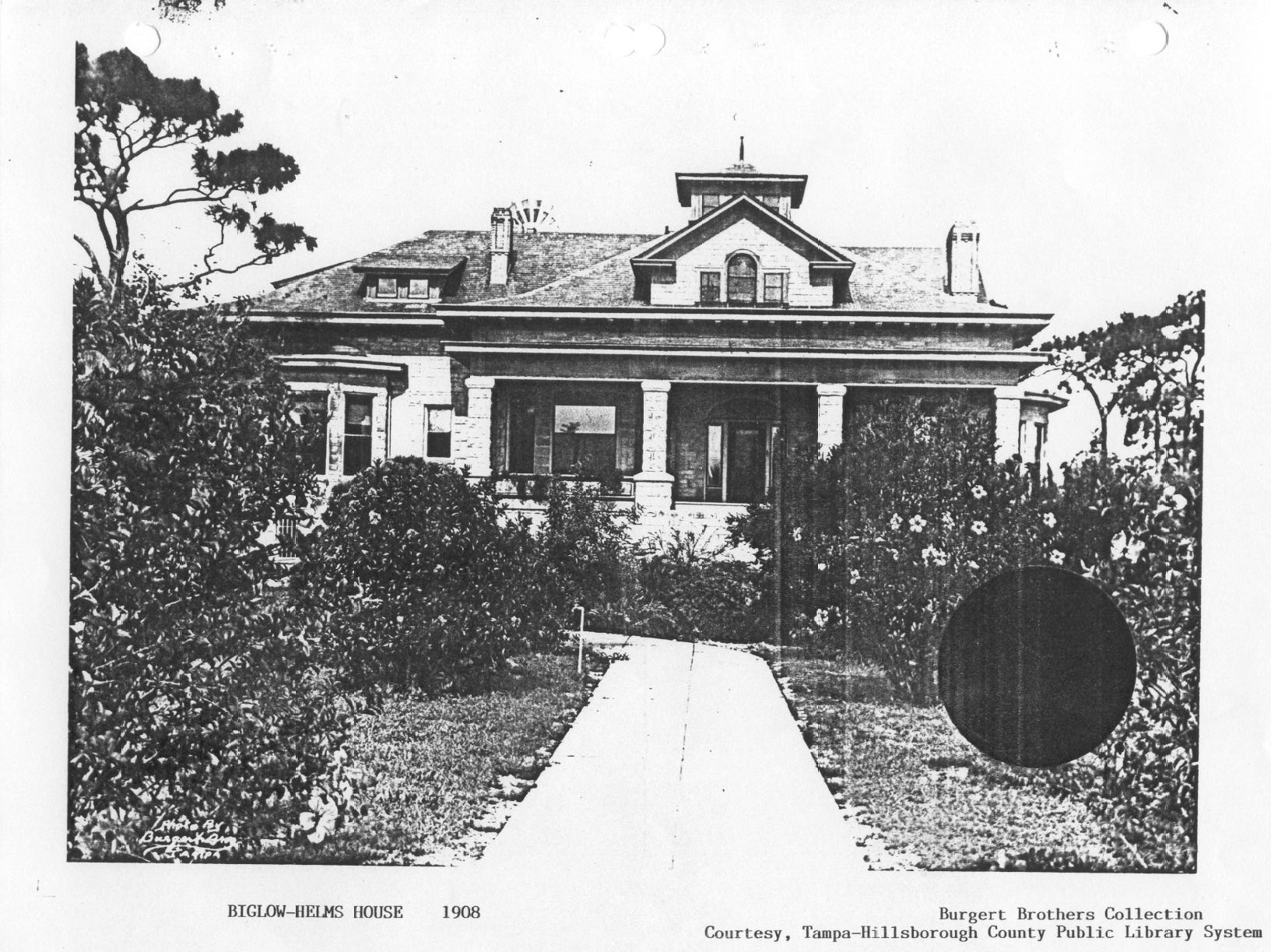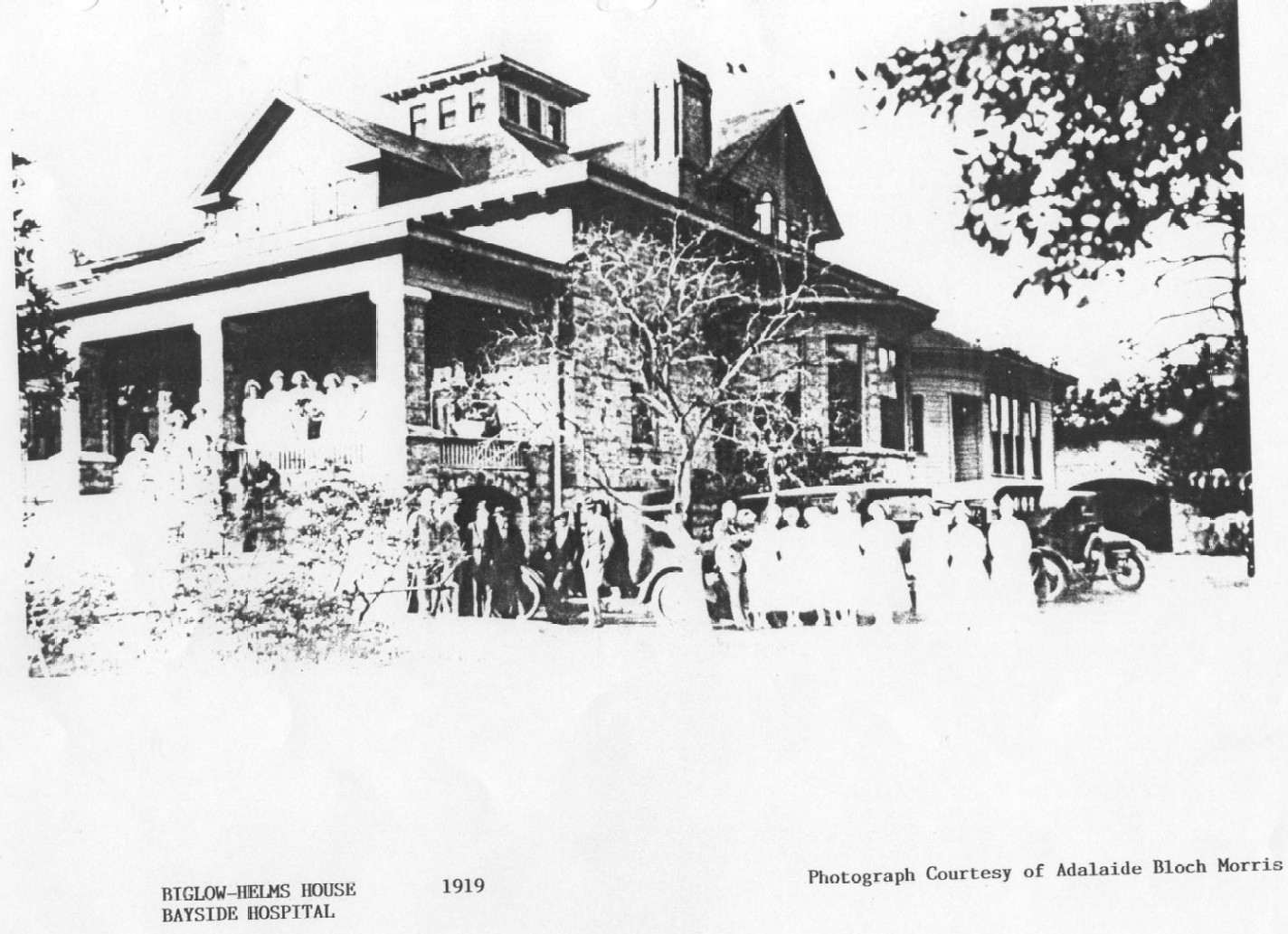
(bigm1908.jpg)

JOHN SULLIVAN HELMS
John Sullivan Helms was born in Ashland, Mississippi on March 23, 1871. He graduated from Southwestern Baptist University and in 1891 completed his medical studies at the Memphis Hospital Medical College. In 1892 he continued with post graduate studies and was an intern in the Memphis City Hospital. During this period he also served as Assistant to the Director of Physical Diagnosis.
For five years after his graduation, Dr. Helms served as an intern in the city and county hospitals of Memphis, advancing to the position of House Surgeon.
In 1896 he relocated his medical practice to Manatee, Florida and in 1900 he moved his practice to Tampa. In an effort to keep up on the newest medical advances, he attended courses in bacteriology and clinical microscopy at a pathological laboratory in Jacksonville.
Dr. Helms was employed as the Consulting Surgeon at the Gordon Keller Memorial Hospital, as Chief Surgeon of the Tampa Children's Home, as Chief of Staff of the John S. Helms Clinic and as Chief of Staff and Director of the Division of Surgery at Bayside Hospital which he established in 1919. After Bayside closed in 1927 he served as Consulting Surgeon at Tampa Municipal Hospital (Tampa General Hospital) until his death in 1932 at the age of 61.
The Tampa Tribune reported that "his character and his deeds should be honored through the years by a permanent memorial" and subsequently, over 100 Tampans organized the John S. Helms Memorial Association. After four years of work on May 30, 1937 a sun dial and memorial bench park adjacent to Tampa Municipal Hospital (Tampa General) was dedicated to honor prominent medical and civic leaders of Tampa. The sun dial that was the focal point of the small tree-lined park was dedicated to the memory of Dr. Helms, with the surrounding benches memorializing his distinguished colleagues.

(bigm1919.jpg)
JOHN BONAKER WILSON
John (Jack) Bonacker Wilson was born in Lakeland, Florida on February 2, 1913. The Bonacker family of Polk County were among the first pioneers to settle in Lakeland. Colonel Bonaker established the first dry-goods store in town during the 1890's. Wilson moved to Tampa with his family in 1920. He attended
-8-
Gorrie Elementary School, Wilson Junior High School and graduated from
Henry B. Plant Senior High School in 1931. Wilson spent the next year studying
at the Ringling School of Art in Sarasota. In 1932 he applied successfully
to John Hopkins Medical School to specialize in medical illustration. During
his association with the School of Medical Illustration, Wilson was ranked
as one of the top six medical illustrators in the United States. He graduated
in 1935 and went on to win a Gold Medal from the American Medical Association
for his work in 1936. Wilson illustrated three medical textbooks for Duke
Medical School while studying portrait art at the Pennsylvania Academy.
In 1939 while working for the Alfred I. DuPont Institute of the Nemours Foundation as Director of Illustration, Wilson began organizing a national association of medical illustrators. Wilson was a charter member of the Associates of Medical Illustrators when the by-laws were approved in 1945. During this period he was chosen by Mrs. Jesse Ball duPont to paint a 16 panel mural depicting the "Story of the Little Lame Prince" for the duPont de Nemours Crippled Children's Hospital under construction in Wilmington, Delaware. This project involved over a year of art history research focusing on 15th century painting and architecture to study the period and style required to execute the illustration for the murals. The murals required another year to produce. His work was completed in Tampa at the second floor studio of the Biglow-Helms house owned by his aunt, Mrs. Dora Bonacker Helms. He was living here in 1942 when he was drafted to serve in World War II. Wilson was discharged in 1945 after attaining the rank of Lieutenant Commander in the Navy. After his discharge he taught at the Ringling School of Art. In 1949 he coordinated and established the first School of Medical Illustrators in the southeast at the University of Georgia.
Wilson moved back to Tampa in the 1950's residing at the Biglow-Helms house and studio. He continued to receive commissions from prominent Tampans for individual and family portraits. The work produced during Wilson's career was exhibited at the Carnegie International Museum in Pittsburg, the Baltimore Museum of Art, the Georgia Centennial Expositon, the Artiste Gallery of New York, the Art Alliance in Philadelphia, and the Lowe Art Gallery in Miami. He held a one-man show at the University of South Florida in 1963.
Wilson died at the Biglow-Helms house on April 28, 1965 at the age of 52.
-9-
III. STATEMENT OF SIGNIFICANCE: CRITERIA
Section 43A-154.j states that a landmark shall have achieved significance within the time period established by criteria of the National Register of Historic Places, which is fifty years.
The Biglow-Helms house was built in 1908, thus qualifying under the general criteria. It qualifies as well under the following criteria:
(5)
Its identification with a person or persons who contributed significantly
to the development of the City, state or nation.
The house is significant for its association with two people who contributed to Tampa's development and an artist of regional importance.
Silas Leland Biglow, member of Tampa's first City Council and President
of that body in 1891, built the house and lived there until 1919. Biglow
served on the Board of Public Works from 1895 to 1909. His interest extended
to the development of Ybor City where he was involved with the Ybor City
Building and Loan Association and the Ybor City Land and Development Company.
Dr. John Sullivan Helms, a prominent Tampa surgeon, purchased the property
in 1919 and converted it to the Bayside Hospital. An advocate of the diagonistic
medicine, Helms established a well-equipped laboratory on the site and
developed one of the outstanding clinics on Florida's West Coast. When
the Tampa Municipal Hospital was established,
Dr. Helms closed Bayside and became Consulting Surgeon at Tampa's first
general hospital.
Jack Wilson, a leading medical illustrator and artist, lived in the house, with his aunt, Mrs. Helms following World War II until his death in 1965. In addition to founding the Associates of Medical Illustrators and the first school of medical illustrators in the southeast at the University of Georgia, he pursued a career as a portrait artist, painting many prominent Tampans during the 1950s.
-10-
Its value as a building with distinguishing characteristics of an architectural style that are significant for the study of a period, method of construction, or use of indigenous materials.
The Biglow-Helms house is significant for its extensive use of "artificial
stone"; that is, concrete blocks molded to simulate the appearance of rusticated
stone. This was a popular building material througout the United States
between 1905 and 1915, and represents an extension of the 19th century
fascination with technological innovation and the clever use of imitative
materials and finish. Poured concrete masonry units, similar to bricks,
were also employed.
These materials were frequently used in the construction of pattern
book houses which drew upon elements of the Prairie style, a uniquely American
school of design, centered in Chicago and most frequently associated with
Frank Lloyd Wright. Although residences constructed of the ornamental concrete
block were not uncommon in other regions, the material was less popular
in Tampa.
-11-
IV. REVIEW OF TESTIMONY
The City of Tampa Architectural Review Commission held a public hearing on August 11, 1988, at 3:30 p.m. at the Friday Morning Musicale Building, 809 Horatio Street, Tampa, Florida to consider recommending the designation of the Biglow-Helms House as a landmark.
The property owner and adjacent property owners were notified by certified mail as of July 27, 1988, fifteen days prior to the hearing. Rik Edmonds, representing Lee Scarfone, the property owner, stated that Mr. Scarfone was neither in favor of nor opposed the designation.
Two members of Tampa Preservation, Inc. and one adjacent property owner spoke in favorof the designation.
Following the testimony, the members of the ARC voted unanimously to
recommend that City Council designate the Biglow-Helms House a City of
Tampa Landmark.
-12-
V. BIBLIOGRAPHY
Cotton, J. Randall. "Ornamental Concrete Block Houses." House Journal.
October 1984. Vol. XII No. 8
"Repairing Ornamental
Concrete Block." The Old-House Journal. November 1984. Vol. XII No. 9
Hillsborough County. Deed Records. Clerk of the Circuit Court,
Hillsborough County Courthouse. Tampa, Fla.
Plat Maps. Clerk of the Circuit Court, Hillsborough County Courthouse,
Tampa, Fla.
Historic Tampa/Hillsborough County Preservation Board. Master Site
Files. Tampa, Fla. Florida
"Insurance Maps of Tampa, Florida." New York: Sanborn Map Company, 1884-1931.
James, Fred J. Letter to Dr. Helms describing condition of Biglow House in 1917. Special Collections. University of South Florida Library, Tampa, Fla.
Johnson, B. F. and Caidwell, A. B. Makers of America. Atlanta, Ga: Florida Edition, 1909. Vol. III.
McAlester, Virginia and Lee. A Field Guide to American Houses. New York: Alfred A. Knopf, 1986.
McKay, D. B. South Florida: Its Builders and Industry Tampa, Fla.: Tampa Daily Times, 1924.
Polk's Tampa City Directory. 1900, 1916, 1926, 1927.
Rerick, Rowland H. Memoirs of Florida, Vol. I. Atlanta, Ga: The Southern Historical Association, 1902.
Robinson, Ernst L. History of Hillsborough County, Narrative and Biographical. St. Augustine, Fla.: The Record Co., 1928.
Tampa Daily Times. August 13, 1929; July 24, 1932; May 29, 1937.
Tampa Tribune, April 28, 1965.
Wilson, John Bonacker. Papers. Special Collections. University of South Florida Library, Tampa, Fla.
-13-

